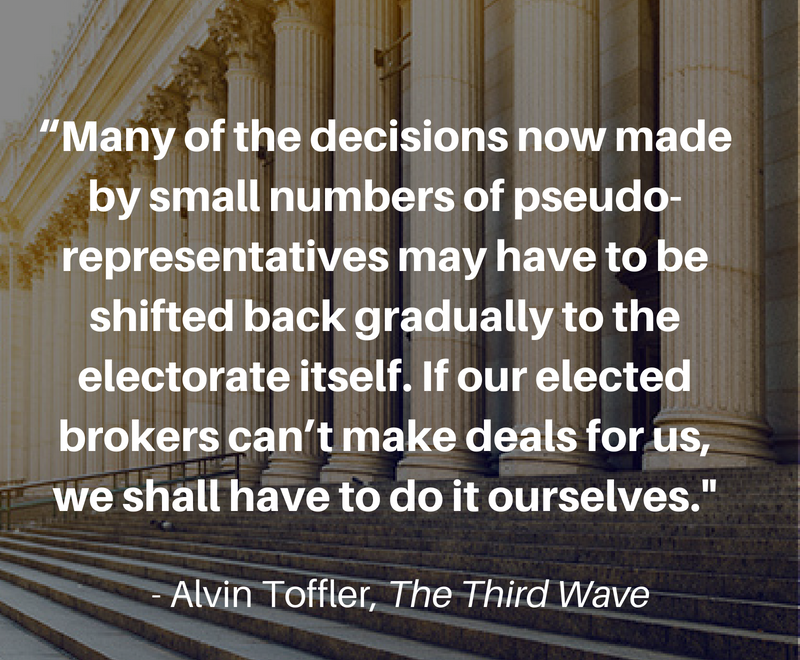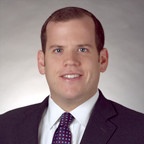Information Transparency and the Future of Democracy

Before the Civil War, Reconstruction, and the Industrial Revolution, the Constitutional system functioned largely the same: white, male landowners riding to the Capitol, casting votes on behalf of their neighbors. American elected representatives would travel long distances to make deals, pass bills, and govern for their constituents. Local needs defined national policies. And days or weeks after votes were counted, the news would reach the citizen population via word of mouth or newspapers.
Twentieth–century technology changed the content, medium, and speed at which Americans learned about political and electoral results. Radio and television in living rooms granted unprecedented access (for that time) to the national information impacting their well-being. Citizens and constituents were granted more opportunity to understand and engage with issues and representatives in a timely manner. Even then, however, that access and response were primarily retrospective in nature.
In 2018, politicians strike deals whose finer details are more-or-less known before the ink dries. We have nearly unprecedented access to “behind closed doors” deliberations, unnamed sources, and global political leaders who engage in debates in 280 characters or less. The populous serves as witness and party to the debates on the merits of legislation, budgets, and even going to war.
Today, it isn’t unimaginable for elected representatives to change positions before voting because their Twitter feed is full of users (some fake) who demand something different. Anonymous sources leak “secret” details of trade agreements that impact stock markets. For better or worse, iPhone cameras and other small recording devices compel many of our representatives to act as if they are being recorded at all times.
How should America’s democratic republic evolve to reflect how our citizens consume and use information?
The Next Phase in an Ongoing Cycle
We may believe that we find ourselves at a unique juncture in American democratic history. True, aspects of what we’ve experienced during the past two years are “firsts” (like an adversary using technology to influence election outcomes.) And our modern two-party rule was unforeseen (and largely undesired) by the Founding Fathers. A careful read on the situation reveals a challenging political architecture that feels not all that unfamiliar. We know from history that our form of democracy is not sacrosanct. We have changed access to voting many times. It may be time for another shift.
Professor and author Walter Russell Mead observes, “The rapid technological, social, and economic changes that the Industrial Revolution brought overwhelmed the institutions that had guided the United States since the American Revolution. It was not just the South that found its old political structures and ideas irrelevant in the wake of the war; in the North, too, the political ideals and the governing institutions of the antebellum world no longer sufficed.”[1]
In a July 2018 article, The Economist relates, “Aware that they could not solve the problem of parties altogether, the founders thought the constitution would at least ensure that they were reasonably numerous and ineffectual. But some of the features they built into it inadvertently encouraged politicians to concentrate themselves into just two blocs. And some of the mechanisms they put in place to guard against other concentrations of power went on to exacerbate the problems that such a two-party system can cause.”[2]
As the national imperatives forced changes to governance, new implications emerged. Parties divided, new ways of disseminating news and information emerged, the people gained more voice. As with any era of fundamental change, questions of reason and response took center stage.
Today is not all that different. Mead continues, “In many cases, citizens of democracies around the world today find themselves in the uncomfortable situation of the postbellum generation: facing problems whose origins cannot be fully understood, and whose solutions will ultimately require intellectual and political architecture that does not yet exist.”[3]
Today’s companies, government entities, and citizens are learning to function in a highly partisan political system in which decisions and news is largely transparent and shared in real-time but may or may not be verifiable. This fluid and tempestuous environment prompts the question – what should the new(est) U.S. “political architecture” look like?
Building a Modern Political Framework
Finding the answer to the question of modern leadership structure begins with answering three initial questions:
- How has transparency impacted our democracy thus far, and what can we expect?
- What is the significance of “trust” in a transparent democracy – both in terms of how we define it and how we rely on it?
- How will speeding up the flow of information and news impact the ways our democracy makes decisions and their ability to take action?
Imagine for a second that our democratic future lies on a spectrum between two extremes. On the one hand, trust in our legislative bodies is depleted. U.S. citizens have wrested total control and influence from elected representatives and own all facets of the governing process (i.e., voting on every piece of legislation). The scenario isn’t all far-fetched. Sixty years ago, 73% of Americans said they trusted the U.S. government. In 2017 that number was 18%.[4]
On the other extreme, leaders and constituents alike put great faith in technologies like machine learning and artificial intelligence (AI). We rely on – and trust – computers to make (or at least inform) optimal decisions on our behalf. Even knowing every political decision fundamentally results in winners and losers, we believe technology will yield objectively optimal decisions. Again, the scenario isn’t far-fetched. Already we allow AI to help make medical diagnoses.[5] Is it too much of a leap to imagine leveraging a version of this very same technology to identify the best location to build a new bridge, the most advantageous tax structure, or satisfactory carbon emission standards?
There’s a middle-of-the-road scenario. The non-government sector (for- and not-for-profit organizations) assumes more responsibility and accountability for providing the basic needs of our society: security, protection, and enforcing the rule of law. In a 2018 Gallup poll, big business garners some level of trust from 70% of Americans; Congress, meanwhile, gets only 52%. Given the demonstrable lack of trust we have in those we chose to represent us and the relative nascence of AI, this third option seems especially provocative.
At Toffler Associates, we advise our clients about the transformations needed to thrive in the Knowledge Age. While there’s much we don’t know about how information transparency will impact the state of trust and electoral responsibility going forward, we do know one thing for certain. No industry, federal agency, institution, or democracy is immune to disruption.
As we consider the unfettered flow of information and its impact on our advancing political climate, the challenge before us is to understand how democracy will adapt and evolve to new norms and customs. It’s a hard question with many possible answers. We envision those answers will come through discussions about our global power centers and who holds the greatest responsibility for solving national and global issues.
It’s time to engage in an open conversation about the future of information sharing and our national democracy.
Click each name to see more from authors John Chase or Hans Davies
John has more than eight years of experience working with large government agencies and multinational corporations. Specifically, he has worked with organizations’ senior leaders and executives to develop long-term strategies, evaluate strategic initiatives, implement risk mitigation strategies, and design approaches to change management. Prior to beginning his career as a consultant, John graduated with a Bachelor Arts—with honors—from the University of Richmond and with a Master of Business Administration from the University of Virginia Darden School of Business.

Hans specializes in strategic planning, risk management, resource management, and innovation policy. He helps organizations strengthen their ability to manage enterprise risk. Prior to joining Toffler Associates, Hans worked at SAIC, supporting arms control and complex operations initiatives for the Department of Defense. He has served as a Congressional staff member, worked with the Department of State, and was a Robert Bosch Foundation Fellow in Germany. Hans earned a B.A. with honors in History from Williams College and an M.A. in International Relations and International Economics from Johns Hopkins University.
[1] https://www.foreignaffairs.com/articles/united-states/2018-04-16/big-shift
[2] https://www.economist.com/briefing/2018/07/12/americas-electoral-system-gives-the-republicans-advantages-over-democrats
[3] Ibid
[4] http://www.people-press.org/2017/12/14/public-trust-in-government-1958-2017/
[5] https://www.technologyreview.com/the-download/610853/fda-approves-first-ai-powered-diagnostic-that-doesnt-need-a-doctors-help/
{{cta(‘bc9ba0a2-ec02-401a-8b7c-a568db3188ce’)}}
- Categories
- Futures and Foresight
- Leadership


 About the Authors
About the Authors